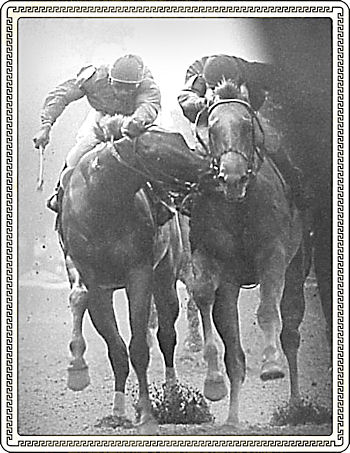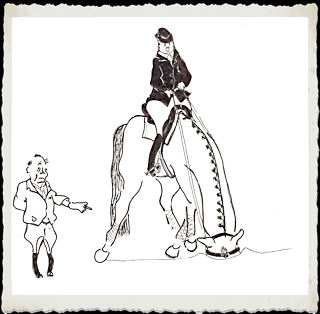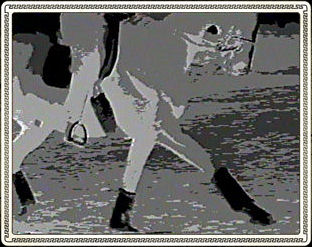|
What Is The Science Of Motion
Part 1
Jean Luc Cornille
|

Introduction to the Science of MotionAnyone introduced to the science of motion enjoys a new quality of life with the horse, is able to perform at levels previously out of reach, and watches the horse's "lameness bill" dropping to virtually no expense. With great enthusiasm, one wants to share with others the fascinating journey but the explanation does not come easily.
It is not that the scientific aspect is heavy. In fact the science is clearly explained and easy to understand. The greatest difference is the kindness to the horse. The equestrian education emphasizes submission. Horses are submitted to a system and failure to perform or lameness is attributed to the horse's poor genetic or bad attitude. In reality, they are many "not good enough" horses who are very good but have their talent downgraded by muscles imbalance, morphological flaws or other defect that submissive techniques attempt to manage but are unable to resolve.
The science of motion is about addressing and correcting the muscles imbalance or the source of the abnormality. It is not done submitting the horse to another system but rather engaging the rider as well as the horse's intelligence. It is a partnership where the rider's knowledge and the horse's mental processing reach a level of body control that opens performances previously inaccessible and the capacity to perform at the horse's fullest potential while remaining sound.
Listening to numerous requests, I decided to provide this "explanation." "What is the Science of Motion" is the long due reference that anyone already engaged in this new perspective expected. For everyone hoping to further their riding skill and their horses' talent, the unprecedented quality of the illustrations and simple clarity of the text elevates What is the Science of Motion as the greatest learning materiel ever made available.
Sincerely, Jean Luc Cornille
Testimonials: I just finished reading your new book for the second time and want to thank you for it. Though it gives a great deal of meaty science-based material, the excellent anatomical renderings really help to illustrate the text. Finally, a book to bring it all together: the science, the training, for the good of the horse. Your unique sense of humor and cartoons were appreciated, as were the photos of you riding. I have to assume that there are other books on the way, and will look for them on your website. Caroyln Sanchez
Jean Luc Cornille's book "What is the Science of Motion?" offers up many gifts. One of the most priceless, in my view, is that the clear explanations combine with photographic images that show precisely what is happening when the rider experiences that glorious (and addictive!) feeling of lightness and self-carriage. Riding with correct images in the mind lets the rider visualize how best to use his or her body in order to help the horse. Pam Black

$55.00 PDF or DVD
|
| Humor of the Month
Winning is not everything. One also needs to take care of adversity.

| |
Greetings!
EDITORIAL
 "Imagination was given to man to compensate for what he is not, and sense of humor to console him for what he is." (Unknown) In an equestrian world where opinions allow very little room for knowledge and humor, this newsletter is an Island. Anyone walking on the sand of a new Isle will explore the new world and discover than in fact the Island is a peninsula leading to a better world. In this better world, horses and riders are partners. They are not business partners, they are life partners and it is a serious business to succeed in such partnership. It is also the success in life and humor is the smoother way to face adversity and preserve kindness.
Walking on Water
As it is easier to evoque mystic power than question familiar beliefs, I am often credited with mysterious powers. When horses achieve performances previously impossible or reverse irreversible problems, people would rather grant me extraordinary abilities than exploring the possibility that conventional methods might not be the only ones.
The greatest credit I ever have been granted is to be "God". I decided that such opinion should be investigated. If I was God, I should be able to walk on water. So, I tried to walk on the water of my swimming pool and I sank to the bottom. The good news is that "impossible" recoveries and extraordinary horses' progress are solely the result of scientific studies. More exactly they are the outcome of the practical application of knowledge. Hence, they can be duplicated and achieved by everyone.
The secret is precisely to realize that no one can walk on water. The truth does not belong to one's opinion nor one's academic, scientific, or competitive credentials. "Knowledge," said James Rooney,"is a work in transition." A theory is nothing more than a stop over along the way, since knowledge of the equine physiology is in constant evolution. Some horses can recover from irreversible problems because the issues were irreversible until someone found the solution. Other horses may unveil outstanding gaits because the outstanding gaits were within their potential all along but their talent was altered by training approaches ill adapted to their physique, or temperament, or both.
Resistance to progress is the outcome of a pathetic and misplaced ego. It condemns both the horse and the rider to live and perform below their potential. For the rider, the situation engenders frustration. For the horse, the outcome is lameness.
The first step toward progress is to "update" whatever we have been taught to actual knowledge of the equine physiology. That is the aim of this newsletter. The journey is fascinating, sometimes provocative, definitively educational, and eminently focused on the partnership between humans and equines.
Ultra conservatives should not be overly worried; fundamental principles remain unchanged. The rider is still facing the horse's neck, the right leg naturally falling along the horse's right side and the left leg along the horse's left side. It is just that everything else is different.
Jean Luc Cornille
Editor Helyn Broadhurst
Science Of Motion
941-961-7101
|
|
Reflections on the Rollkur
part 25,736.00

Oops! You need a forklift!
In 1825, the Prussian cavalry's regulations emphasized the total elevation of the horse's head and neck. The experiment lasted several decades then was abandoned completely. The theory behind the technique was that total elevation of the neck was enhancing the horse's balance, developing the back muscles, and engaging the hind legs. By contrast, the Prussian Emperor's Riding Master, lowered and over-flexed his horses' necks completely. Paul Splinzner(1853-1920), in fact created the "rollkur". His theory was that such over-flexion of the neck was enhancing the horse's balance, developing the back muscles, and engaging the hind legs. Almost contemporarily and on the other side of the Rhine River, Francois Baucher(1776-1873) promoted in his "dernier enseignements" the systematic elevation of the neck. His view was that such elevation of the neck was enhancing the horse's balance, developing the back muscles, and engaging the hind legs. Half a century later, Jack Licart(1951) reinvented the lowering of the neck. His theory was that the lowering of the neck was enhancing the horse's balance, developing the back muscles, and engaging the hind legs. Not long ago, Harry Bolt (1973) warned against the practice of over-flexing the neck. Today no one can win without over-flexing the horse's neck completely.
Obviously, the relationship between neck posture and vertebral column's mechanism is more a mater of opinion than scientific documentation. Twenty five thousand, seven hundred and thirty six opinions later, the question:"what does the Rollkurdo to horses,"remains unanswered. Olympic riders are winning practicing this technique and therefore anyone anxious to win feels that over-flexing the horse's neck is the price of winning. Click here to READ ON |
Test Your Feeling
 Would you like to measure your perception? Click on the link Equestrian Art. The video sequence was originally created to educate the eye of the Boulder School of Massage Therapy's students. The though was to emphasize the notion that noxious stimulus (pain) is not a consistently direct indicator of the location of the muscular imbalances causing the problem. The horse pictured on the video is heavily digitalized. One can recognize the horse's silhouette but cannot clearly distinct the details. The purpose is to concentrates the viewer's eye on the horse's motion. The music emphasizes the horse's cadence. At the first view, you will clearly see the moments where the horse is loosing the tempo. Watching again you will "feel" the muscles contractions that are causing the lost of rhythm and amplitude. Let us know what you think. jeanluc@scienceofmotion.com |
About Science Of Motion
An interview of Jean Luc will be published this month (December) in the online magazine Horse for Life.
We have added fine art photographers Bob Snell and Scarlet James to our Equestrian art gallery.
Stay tuned for the new website's first page!
Have great holidays!
Jean Luc and Helyn
Science Of Motion
4785 47th Street
Sarasota, Florida 34235
941-961-7101
|
|